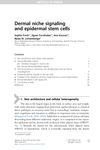TLDR Synthetic hyaluronic acid speeds up wound healing.
The study investigates the effects of synthetic hyaluronic acid injections on wound healing in sutured incisions in BALB/c mice. The results indicate that hyaluronic acid significantly enhances wound healing by promoting fibroblast accumulation, collagen fiber proliferation, granulation tissue formation, and epithelialization. These findings suggest that hyaluronic acid could be a beneficial treatment for improving wound healing processes.
 12 citations
,
February 2022 in “Acta Biomaterialia”
12 citations
,
February 2022 in “Acta Biomaterialia” Minoxidil-loaded hyaluronic acid microneedles can effectively increase hair growth and could be a promising treatment for hair loss.
34 citations
,
September 2020 in “Clinical, cosmetic and investigational dermatology” Hyaluronic acid increases collagen synthesis safely, while poly-L-lactic acid may cause complications by affecting fibroblasts.
12 citations
,
June 2023 in “International Journal of Molecular Sciences” Innovative biomaterials show promise in healing chronic diabetic foot ulcers.
April 2024 in “International journal of molecular sciences” Combination pharmacotherapy is generally more effective for treating keloids and hypertrophic scars.
61 citations
,
April 2023 in “Bioactive Materials” Microneedles are effective for painless drug delivery and promoting wound healing and tissue regeneration.

Dermal stem cells help regenerate hair follicles and heal skin wounds.
 January 2019 in “Advances in stem cells and their niches”
January 2019 in “Advances in stem cells and their niches” Skin health and repair depend on the signals between skin stem cells and their surrounding cells.



